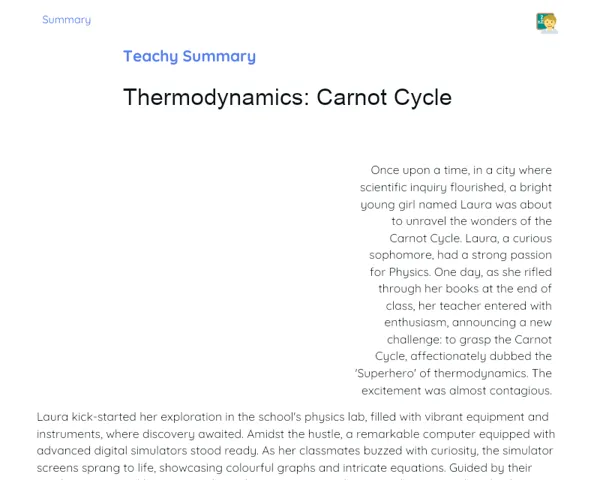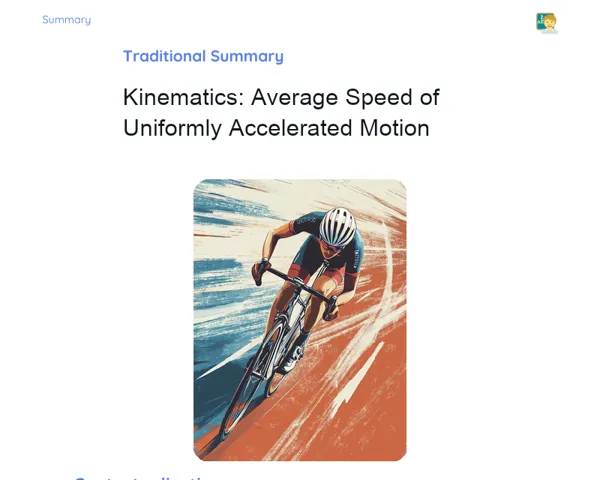Summary Tradisional | Kinematics: Angular Displacement
Contextualization
In physics, kinematics is the branch that explains the motion of objects without delving into what causes that motion. Within this realm, we encounter various types of motion, such as linear motion and angular motion. While linear motion pertains to the movement of an object in a straight line, angular motion involves the motion of an object around a specific point or axis, which we measure in angles.
Angular displacement is a vital concept when we consider circular motions. For instance, when we track the movement of the hands of a clock, we are observing angular displacement. Likewise, when we look at a car or bicycle wheels, we notice how these objects move along circular paths. These principles are not just theoretical; they have numerous practical applications in our daily lives and modern technology.
To Remember!
Linear and Angular Displacement
Linear displacement refers to straight-line movement of an object. It measures the distance travelled, usually in meters. As a vector quantity, linear displacement has both magnitude and direction. A straightforward example is a car cruising down a straight road.
In contrast, angular displacement examines an object's movement around a point or axis. Rather than measuring distance, it looks at the change in angle, typically expressed in degrees or radians. This concept is essential for understanding circular motions, such as how the hands of a clock move or how a car's wheels operate.
The crux of the matter is that linear displacement measures length, while angular displacement gauges angles. Both are crucial in describing various types of motion in kinematics.
-
Linear displacement: movement along a straight line.
-
Angular displacement: movement around a point or axis.
-
Measurements: meters for linear displacement; degrees or radians for angular displacement.
Units of Measurement
For angular displacement, the predominant units of measurement are degrees and radians. A complete circle constitutes 360 degrees or 2π radians. To convert from degrees to radians, we apply the conversion π radians = 180 degrees. Hence, 1 degree equals π/180 radians and 1 radian equals 180/π degrees.
Degrees are ubiquitous in our daily lives, especially on analog clocks, where each minute equates to 6 degrees of angular movement (360 degrees divided by 60 minutes). Radians find more frequent application in scientific and mathematical contexts since they relate directly to the geometric properties of circles.
Grasping these units and their conversions is key for accurately determining angular displacements and utilizing these principles in both practical and theoretical situations.
-
Degrees: 360 degrees in a full circle.
-
Radians: 2π radians in a full circle.
-
Conversion: 1 degree = π/180 radians, 1 radian = 180/π degrees.
Calculating Angular Displacement
To calculate angular displacement, we use the formula Δθ = θ_final - θ_initial, where Δθ indicates angular displacement, θ_final is the final angle, and θ_initial is the starting angle. This formula allows us to find how much the angle has changed as an object rotates around a point or axis.
For example, if the minute hand of a clock moves from 12:00 to 12:15, the initial angle is 0 degrees, and the final angle is 90 degrees. Therefore, the angular displacement is Δθ = 90 degrees - 0 degrees = 90 degrees. When converting to radians, we apply π radians = 180 degrees, which leads to Δθ = π/2 radians.
This fundamental formula is invaluable for tackling circular motion problems and for understanding how objects move along circular paths. Practising this formula in diverse contexts solidifies our grasp of angular displacement.
-
Formula: Δθ = θ_final - θ_initial.
-
Application: calculation of the change in angle.
-
Example: movement of the hands of a clock.
Relationship Between Linear and Angular Displacement
The correlation between linear and angular displacement is articulated in the formula s = r * Δθ, where s is the linear displacement, r is the radius of the circular path, and Δθ is the angular displacement in radians. This equation illustrates how we can derive linear displacement from angular displacement and the circumference of the path.
For instance, if a bicycle wheel with a radius of 0.3 meters rotates through an angle of 120 degrees (or 2π/3 radians), the linear displacement at the edge of the wheel would be s = 0.3 * 2π/3 ≈ 0.628 meters. Such calculations are pivotal for comprehending how portions of an object in circular motion move.
Grasping this relation is critical for addressing practical issues pertaining to circular motion, ranging from designing gear systems to studying the motion of satellites and planets. Utilizing this formula deepens our understanding of kinematic principles.
-
Formula: s = r * Δθ.
-
Application: calculating the linear displacement from angular displacement.
-
Importance: essential for understanding circular motions.
Key Terms
-
Linear Displacement: Movement along a straight line, measured in meters.
-
Angular Displacement: Movement around a point or axis, measured in angles (degrees or radians).
-
Degrees: Unit of angle measurement, with a full circle having 360 degrees.
-
Radians: Unit of angle measurement, with a full circle having 2π radians.
-
Angular Displacement Formula: Δθ = θ_final - θ_initial, used to calculate the change in angle.
-
Relationship between Linear and Angular Displacement: s = r * Δθ, which relates linear displacement to angular displacement and the radius of the path.
Important Conclusions
In this lesson, we delved into the distinct concepts of linear and angular displacement, underscoring their essential differences. Linear displacement signifies straight-line movement, whereas angular displacement refers to movement about a point or axis, quantified in angles. Recognizing these distinctions is vital for analyzing various motions within kinematics.
We also discussed the units employed for measuring angular displacement, including degrees and radians, highlighting the importance of unit conversion for precise calculations. We explored the angular displacement formula (Δθ = θ_final - θ_initial) and the mathematical relationship between linear and angular displacement (s = r * Δθ) through practical examples, such as clock hand movements and a vehicle navigating a circular track.
Mastering these concepts is crucial not only for theoretical physics but also for practical technology applications. The insights gained empower us to better understand the circular motions of objects and their significance in daily devices like clocks and gears. We encourage you all to explore this topic further and apply these concepts across different settings.
Study Tips
-
Revisit the practical examples discussed in class, such as clock hand movements and a vehicle on a circular track, to solidify your understanding of angular displacement.
-
Practice converting between degrees and radians, and apply the formulas for angular displacement and its relationship to linear displacement across various problems.
-
Explore additional resources, such as explanatory videos and hands-on exercises, to enhance your understanding of circular motions and their applications in different fields.



